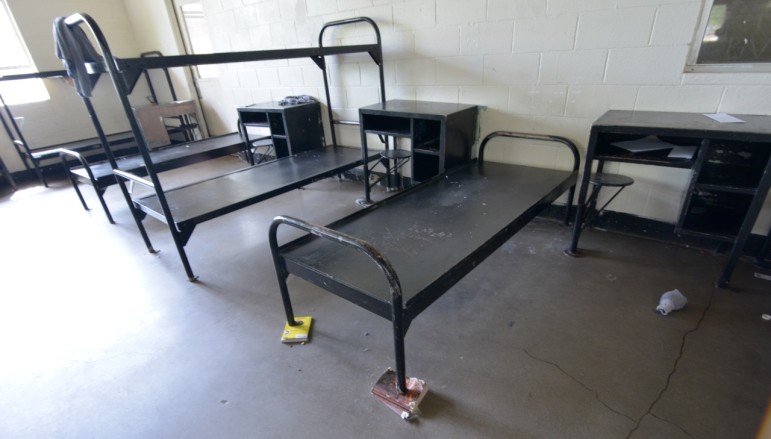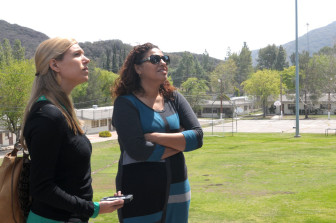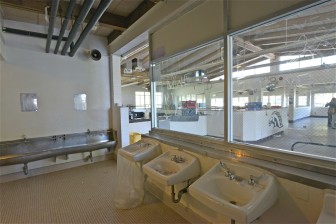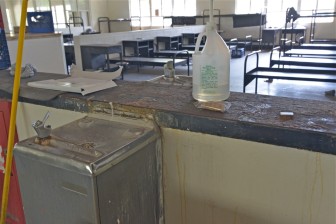
Mark Lawson Shepard
Bunks in the dorms of Camp Kilpatrick, soon to be replaced in a state-of-the-art facility.
MALIBU, Calif. — Don Meyer has seen more than his share of approaches aimed at rehabilitating kids during his nearly five decades working in California’s juvenile justice systems. Those approaches — from boot camps to sports programs to jail-like detention facilities — have had limited success in rehabilitating kids and preventing recidivism. But now Meyer, an assistant chief probation officer in Los Angeles County, is excited about a bold new model undertaken at Camp Kilpatrick, a juvenile detention facility nestled in the canyons of the Santa Monica Mountains.
Camp Kilpatrick opened in the early 1960s in Malibu and has long been one of the best known juvenile detention facilities in California. The camp has been lauded for its sports program, which inspired the Hollywood movie "Gridiron Gang." But it's also been heavily criticized by juvenile justice advocates and social scientists for its neglected facilities and outdated practices, which have led to poor outcomes for incarcerated youth.
 The camp was closed in March and most of its 14 buildings are scheduled to be torn down this summer. They will be replaced by a new $48 million state-of-the-art facility, scheduled to open in 2016 or 2017, that will be centered on rehabilitation, education and training. Incarcerated youth will be housed in small group settings of 10-12 juveniles instead of the open dorms that housed up to 80 juveniles. Education, counseling and vocational training will be stressed.
The camp was closed in March and most of its 14 buildings are scheduled to be torn down this summer. They will be replaced by a new $48 million state-of-the-art facility, scheduled to open in 2016 or 2017, that will be centered on rehabilitation, education and training. Incarcerated youth will be housed in small group settings of 10-12 juveniles instead of the open dorms that housed up to 80 juveniles. Education, counseling and vocational training will be stressed.
Meyer and other juvenile justice advocates stress that the significance of the Camp Kilpatrick project goes well beyond a single rebuilt facility. Among other things, they point out that the new Camp Kilpatrick has a good chance at success because it is based on the latest scientific research. That research clearly shows that a rehabilitative small group model, which began to emerge in Massachusetts in the 1960s and has more recently been implemented in Missouri, Washington, D.C., and California’s Santa Clara County, significantly reduces recidivism rates.

Mark Lawson Shepard
Michelle Newell of the Children's Defense Fund (left) and Dalila Fragoso, probation director of Camp Kilpatrick (right), talk about the future of the camp (in background).
"It's not just about tearing down and rebuilding a facility,” says Michelle Newell, a senior policy advocate for the Children's Defense Fund and co-author of a UCLA and Children’s Defense Fund-California report on reforming LA's juvenile justice system. “This is a new model, a new philosophy, a new approach."
Carol Chodroff, an attorney and former staff counsel to the U.S. House of Representatives Committee on the Judiciary, agrees. "This is an opportunity to do things consistent with research with respect to best practices and juvenile justice,” she says. “The setting is group based and not so punitive, and it focuses on children’s potential and rehabilitation and bolstering their strengths — rather than just taking a lock-them-up and throw-away-the-key approach.”
 And Meyer, who has been working in various positions in the juvenile justice system since 1966 and is now 69 years old, says he strongly believes that the small group rehabilitation model will be successful at Camp Kilpatrick, and could pave the way for similar changes throughout Los Angeles County and all of California. “I’m absolutely optimistic,” Meyer says. “It is working in at least three other places.” He adds that the goal of the new model is to reduce recidivism rates from about 40 percent to 20 percent or less.
And Meyer, who has been working in various positions in the juvenile justice system since 1966 and is now 69 years old, says he strongly believes that the small group rehabilitation model will be successful at Camp Kilpatrick, and could pave the way for similar changes throughout Los Angeles County and all of California. “I’m absolutely optimistic,” Meyer says. “It is working in at least three other places.” He adds that the goal of the new model is to reduce recidivism rates from about 40 percent to 20 percent or less.
Camp Kilpatrick is one of 14 probation camps in Los Angeles County, which has the largest juvenile justice system in the nation. Most of the camps were built during the 1950s and 1960s, and they are characterized by penitentiary-like facilities and strictly enforced routines. In a 2012 letter to the Los Angeles County Board of Supervisors, the county’s chief probation officer Jerry Powers has described the design of the probation camps as “creat(ing) an image of a jail-like environment.”
In the UCLA report on reforming Los Angeles County’s juvenile justice system, Newell and her co-author, Jorja Leap, describe numerous consequences of the outdated design. The barracks-like dormitories do not foster rehabilitation and only serve to foster competition, deepen factions and further gang problems. Youth interaction with staff is inconsistent and often adversarial. Safety problems persist. And educational opportunities are inconsistent.
“Even the newest Los Angeles County probation camp — Challenger Memorial Youth Center, which opened in 1990 in a geographically remote area with a command-and-control program — represents an outdated era of juvenile justice that does not meet the needs of today’s system-involved youth,” the report states.
The new model envisions small dorms of 10-12 youth, with a living room area and private bathrooms, in sharp contrast to the current facilities and their large open dorms with 50-120 beds in military barracks style, open bathrooms and no privacy. It envisions a better staff-to-youth ratio, one where staff have regular schedules that support working with youth, consistency and relationship building rather than 56-hour work schedules with 16-hour shifts, with staff then gone for several days. And it envisions an environment where safety is promoted through strong relationships, and where isolation rooms are eliminated.

Mark Lawson Shepard
Once criticized for its neglected facilities and outdated practices, Camp Kilpatrick looks to provide a safer and more comfortable environment in the upcoming redesign.
“You need an environment that’s conducive to positive youth development, that feels normal, that feels safe, that feels comfortable, that feels homelike,” Newell told JJIE. The rebuilt Camp Kilpatrick facility, she adds, “will really be designed with rehabilitation in mind — what do youth need, and how can the facility design help support this.”
Similar approaches have worked in Missouri, Washington, D.C., and Santa Clara County.
The small group rehabilitation approach has been particularly successful in Missouri, reducing recidivism to one of the lowest rates in the country. The hallmark of Missouri’s system is small, cottage-like facilities at locations that keep juveniles close to their own homes and emphasize rehabilitation. As one indication, in 2011 only 6.9 percent of youth discharged from Missouri’s Division of Youth Services were recommitted for new juvenile offenses within one year. The approach has been so successful that juvenile justice advocates refer to it as the “Missouri Miracle.”
In Washington, D.C., the Oak Hill Youth Center was characterized by dangerous and overcrowded conditions, and 51 percent of the center’s juveniles were re-arrested within a year after being discharged. After a new, 60-bed facility, designed on the Missouri model, was built, the recidivism rate dropped to 35 percent by 2010.
In Santa Clara, Calif., the recidivism rate at the William F. James Boys Ranch was more than 40 percent. Then, officials publicly acknowledged the program was failing, and they adopted a small-group approach based on the Missouri model. In 2011, with the new model in effect, the recidivism rate had dropped to 21 percent.

Mark Lawson Shepard
Camp Kilpatrick was once one of 14 probation camps in Los Angeles County.
The Camp Kilpatrick transformation will be based on the Missouri model, but it will be tailored to specific needs in Los Angeles County. For example, a project-based learning education model called Road to Success Academy (which has been piloted in other LA County probation camps) is expected to be the educational model, which is intended to complement the other components of the Missouri model.
The project is being funded primarily through a juvenile justice realignment bill passed by the California state Legislature in 2007, which created new funding for counties to improve their facilities. Los Angeles County got the go-ahead to rebuild one of its probation camps based on best practices, and it selected Camp Kilpatrick because it was physically in the worst shape. The county has been working with researchers and juvenile justice advocates on the new design model.
The county is expected to select a design and building firm in the coming months, and the rebuilt Camp Kilpatrick will likely open in 2016 or 2017.
The plan is not without controversy, because the fate of Camp Kilpatrick's acclaimed sports program is uncertain (for decades, Camp Kilpatrick has been the only juvenile justice facility in California to field sports teams that competed against public and private schools). Still, juvenile justice advocates and others say the new rebuilt facility will better serve incarcerated youth in Los Angeles and could be the future of a more effective juvenile justice system throughout California and the entire nation.
With his long experience in juvenile justice, Don Meyer knows it won’t be easy.
“You have to make sure you stay true to a model developed based on science and have data available to show if it is resulting in kids becoming more successful,” he cautions. Still, he and others say Camp Kilpatrick could become the future of juvenile justice in California.
“We see this as a really big opportunity to rethink juvenile justice in Los Angeles County and to move away from an outdated, harmful approach to a much more helpful model,” says Newell.
Financial supporters of The JJIE may be quoted or mentioned in our stories. They may also be the subjects of our stories.

